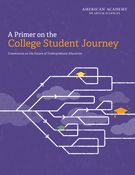Think Humanities Grads Can’t Find Meaningful Work? Check the Facts.
Despite the resourcefulness and creativity that characterizes American higher education, the failure of many colleges to rethink how they will continue to support the educational enterprise over the long-term keeps most administrators awake at night.
But there is some good news out there. Surprisingly, much of it centers on the careers of arts and humanities graduates.
Mainstream and social media tend to portray arts and humanities graduates as underemployed and overeducated, flipping burgers or making cappuccino, a stereotype that is refuted by a recent study.
The American Academy of Arts & Sciences found that arts and humanities graduates like what they do after graduation, feel fulfilled by it, and advance steadily in their careers.
The study surveyed humanities graduates about salary, status at work, and level of job satisfaction. In a recent interview, Robert Townsend, the academy’s director for the Washington office, expressed hope that the findings might change the conversation: “I think the top-line numbers about earnings still tend to drive much of the conversation, while the counterexamples are too often anecdata. Hopefully, these numbers will provide for a better-grounded discussion.”
Liberal Arts Grads Start with Lower Salaries But Catch Up with STEM, Biz Grads
Using government data and Gallup polling of workers nationwide, the academy found that arts and humanities graduates begin their careers with lower average starting salaries. The average annual salary for those holding a bachelor’s degree in the humanities was $52,000, 15 percent less than the average of $60,000 for all majors was $60,000 and significantly behind the $82,000 average earned by those with undergraduate engineering degrees.
But here’s the surprise: Arts and humanities graduates report a high level of job satisfaction; indeed, nearly 87% of these workers were satisfied with their job in 2015.
Matthew Hora, a University of Wisconsin professor in the liberal arts and applied studies, noted in the Chronicle of Higher Education that the AASS study should “contradict the popular narrative about under-employed baristas and the need to redirect students away from these disciplines.”
In addition, the AAA&S study found that over time the wages of arts and humanities graduates catch up to workers with STEM and business degrees.
The report also finds that humanities majors are flexible, not bound to a specific career, and employable in a wide range of fields. One telling note, however, is that many arts and humanities majors do not see an explicit link between their undergraduate training and the job that they hold.
Outcomes are Wonderful Defense of the Liberal Arts
These outcomes and findings represent a wonderful defense of the liberal arts. Neither liberal in a political sense nor narrowly about art, the liberal arts train American undergraduates to think. Students learn to speak, write, apply quantitative methods, use technology, and work in collaborative settings. These are the skills that employers seek in recent graduates.
And by and large – often depending upon how carefully the college integrates the liberal arts into the curriculum – it explains why humanities majors are desirable employees. Look at it this way:
Would you rather have as a new employee an engineer trained narrowly as an engineer or an engineer more broadly trained as an engineer in the liberal arts?
On a macro level, the viability of American higher education rests on a curriculum that trains the next creative generation of graduates upon which American society will depend.
Policy Makers and Legislators Should Heed Study Results
The study’s findings shine a light on the need for that fresh thinking. First, lawmakers, especially at the state level, must understand that a flexible, nimble, and broadly educated workforce is better than a narrowly trained one.
The quality and versatility of the American workforce will be diminished by efforts to redirect money only to the graduates in technical fields.
College & University Leaders Should Reinforce Value of Liberal Arts Education
It would also be wise for colleges and universities to reinforce the value of a liberal arts education to arts and humanities majors who, as the study suggests, use what they learned in the workforce without recognizing how their training made them among the most employable across it.
An English major who can write or speak compellingly is just as valuable as a history major who can interpret data. Look at the global corporate, political, educational and social leadership to illustrate this point.
And finally, there is a pay gap between arts and humanities majors and their counterparts in the first years after graduation. Loan repayment programs should be graded for repayment in some part by the starting salaries of recent graduates.
An elementary school teacher and an engineer have different initial resources and skill sets, yet both contribute to their fields of employment. Further, there should be a cut-off below which college graduates should not be expected to repay their loans until their salary level improves.
The theory is simple. America needs a fully functioning, comprehensive workforce. It should not pick winners and losers. However, it can support an informed, educated, and creative citizenry that provides the range and balance to weather unimagined changes in the global workforce.


